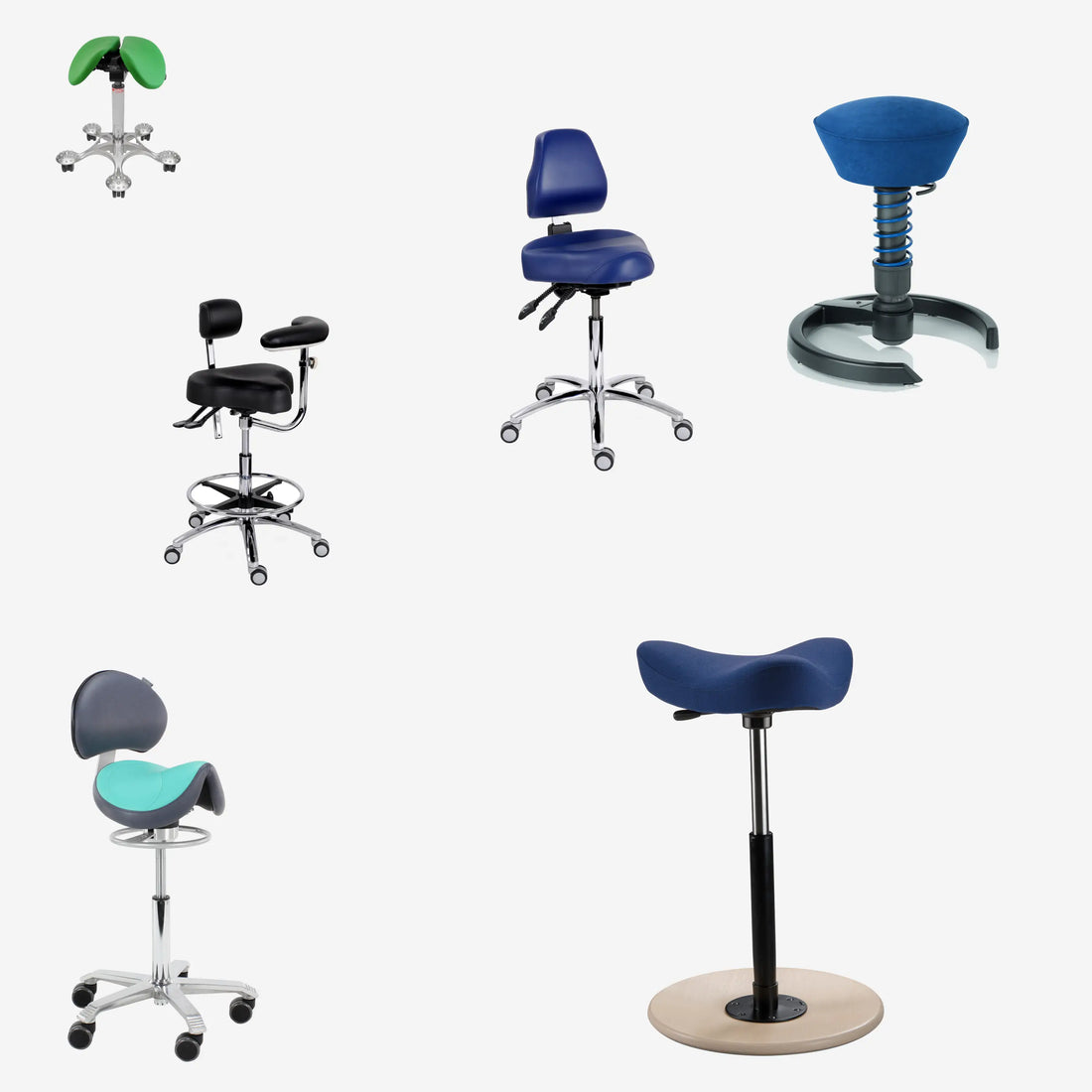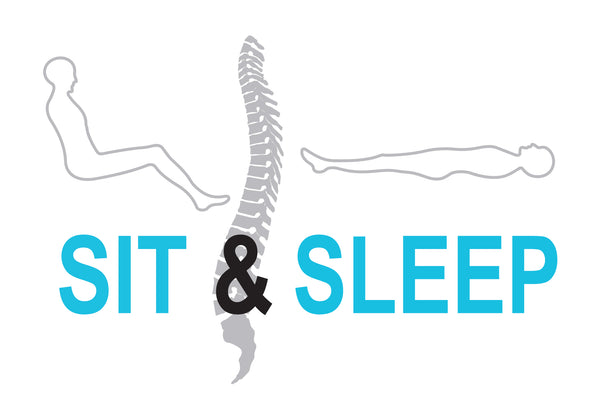
How do I choose the right saddle stool?
What is a saddle stool?
A saddle chair is a comfortable (and functional) chair often used in workplaces where there's a lot of alternating between standing and sitting. The ergonomically shaped saddle seat ensures the correct sitting position with the feet firmly on the ground. A saddle chair relieves pressure on the lower back and legs because they no longer have to bear the full body weight, and they promote good blood circulation. They all have a specific shape that tilts your thighs downward and tilts your pelvis forward instead of backward as on a regular stool. This creates a neutral position for your lower back. Moreover, most saddle chairs are adjustable, so they can be adapted to the specific needs of the user.
There are different types of saddles, such as a 3-point saddle, the original saddle, and saddles with split seats (refer to the numbered photos below). Saddles are often available in different widths. Some can be adjusted to fit. The advantage of a 3-point saddle is that you can sit comfortably anywhere. This is because the angles are symmetrical. The original saddle is the most common.
Why a saddle stool?
A saddle chair allows you to sit comfortably with a wide, open hip angle and maintains a neutral, low back position. The higher you can position the chair, the more this feature will be utilized. The saddle-shaped seat prevents you from sliding off the chair.
When we sit normally, with 90-degree hip and knee angles, our balance and posture are not optimal. This affects many areas of the upper body and reduces blood circulation. The poor posture caused by standard chairs is inevitable because the pelvis tilts backward, increasing pressure on the intervertebral discs by as much as 30 percent.
Besides seating comfort, saddle chairs also offer several practical advantages. They are easy to move and take up little space, making them an ideal solution for smaller offices and classrooms. Furthermore, they are easy to clean and maintain, making them suitable for public spaces.
When do I use a saddle stool?
Typical professions where a saddle chair is used often have work environments that allow for some adjustment. A dentist or hairdresser, for example, can adjust the client's seat height at any time. An architect's drafting table can be easily adjusted from a classic sitting position to a standing position. When alternating between a saddle chair and standing, it's therefore desirable that the work surface or environment is height-adjustable.
A saddle chair also works well in high-ceilinged work environments or environments with limited legroom. A non-adjustable working height means the saddle chair must be adapted to the environment. To allow for an open hip angle for both adults and children, the table must be high. At a traditional 75 cm table, the saddle shape is of no benefit because people work in a traditional sitting position with their hips and knees at a 90° angle. At a table height of 85 cm, the thighs will create an open angle with the torso.
What are the benefits of a saddle stool?
The saddle shape encourages a pronounced open hip angle. The higher you sit, the greater the angle between your torso and thighs. This is a key difference from a high chair, where the seat is usually flat and horizontal. Because the thighs hang down, it's a suitable solution for limited legroom.
A saddle chair, as a variation on standing work, is actually dynamic sitting at a macro level. The classic sitting position is interrupted by other postures.
The saddle chair also has the advantage that it usually doesn't require a footrest. At a fixed (high) table, a shorter employee will simply sit at a wider hip angle, while a taller employee will sit closer to a classic sitting position. Everyone can then rest their feet flat on the floor. With a standard high chair, on the other hand, an adjustable footrest is always necessary.
Can I use a saddle chair at a “normal” desk?
At a high desk, you can definitely use a saddle chair. Of course, you'll maintain contact with your feet flat on the floor, or you can use a footstool or foot ring if the worktop is still too high. Think of working at a counter, cash register, very high workbench, etc.
But conversely, we do not consider a saddle chair to be the ideal choice of chair for use at a "normal" table height of approximately 75 cm, because the hip angle then shifts back towards 90°. This is an advantage for children, young people or adults of short stature, as if the table were otherwise too high, they can now sit higher.
It is important that you have good support for your arms when using a saddle chair, as a saddle chair (usually) does not provide proper support for your arms and shoulders.
What is the best saddle stool?
A good saddle chair is most effective when the legs are spread apart and tilted downward at a 45-degree angle, which automatically tilts the pelvis forward and maintains a neutral back position. A good saddle chair also needs to be one that suits your body type. Ideally, choose a wider saddle for a wide pelvis and a narrower saddle for a narrow pelvis. Of course, personal preference also plays a role.
It's best to have saddle chairs equipped with a tilting mechanism or a balance mechanism. If you're sitting on a saddle chair for extended periods at a fixed workstation with limited legroom, a dynamic saddle chair is required. This type of chair encourages movement. This is important because prolonged sitting prevents sufficient blood circulation to the body. Insufficient movement, therefore, leads to a reduced oxygen supply, one of the reasons why you start to feel drowsy after sitting for long periods.
The tilting mechanism
It serves to tilt the pelvis, allowing you to find a good posture on the stool. There are tilting mechanisms located directly under the seat. These are released with a lever. You can then adjust the seat angle so your pelvis is at the most comfortable angle.
The balance mechanism
Ensures that the saddle moves in the direction of the upper body's center of gravity as the user adjusts their posture. The pelvis and spine remain balanced, and pressure points, such as the inner thighs and pubic bone, are relieved. This active way of sitting promotes blood circulation and trains and strengthens the back muscles.
Another form of dynamic seating is saddle chairs that can move with the work due to a spherical base or a moving gas lift. This allows you to work close to your body and requires less reach on the work surface. A potential disadvantage of a moving base, however, is that it offers less stability during precision tasks.
A saddle made of one piece or two halves?
There are saddles that consist of one piece or two halves. The choice is primarily based on comfort.
With a one-piece saddle stool, the pressure on the pelvic opening is greater. Often, when the pressure on the pelvis becomes too high, you try to relieve it by tilting the pelvis backward, which causes the back to round. This often happens automatically. However, a rounded back position can cause numerous discomfort because it's an unnatural posture. Moreover, extra pressure on the pelvis can sometimes result in numbness in the genital area due to the excessive pressure. This is especially unpleasant. If the pressure on the pelvis, coccyx, pelvic floor, and/or genital area is too high, it's better to choose a saddle stool with a saddle that consists of two halves.
When sitting on a two-piece saddle stool, the pressure is on the ischial tuberosities rather than on the soft tissue, which can increase comfort in a balanced position, and also allows for uninterrupted circulation. The settings can often be selected to suit the individual's needs.
What should I pay attention to when purchasing a saddle stool?
- Good thickness of the soft part/padding – otherwise you will get pain in your sitting bones
- Good wheels suitable for the surface you're using – they need to roll smoothly to be beneficial. And if the wheels lock up (frequently), it can cause back problems.
- In most cases, a narrow base is sufficient – this is the width of the leg/wheels – such a narrow cross-foot base moves more easily around your desk or workspace without bumping into anything.
- Saddle stools are usually gas-assisted. These are available in various heights, allowing you to adjust the stool to your height. Consider your own height and how you intend to use the stool. On a saddle stool, your thighs are angled downward—about 135/150° relative to your torso—so your seat is considerably higher than when sitting on a chair. However, there's some leeway, so also consider the height of your workstation.
- Studies have shown that prolonged sitting on a chair without a backrest provides insufficient support for the lower and middle back muscles and leads to muscle fatigue more quickly, resulting in poor posture. Therefore, saddle chairs are not recommended for prolonged use (several hours at a time in a work environment) unless they are equipped with a backrest.
The purpose of your saddle stool, your body type, and your own preferences will determine which saddle stool you choose. If you also choose the right accessories—those that enhance your work, such as a backrest or the right wheels—you'll have an ideal tool for ergonomic work.





